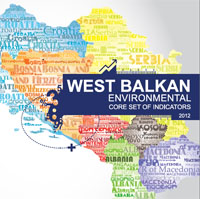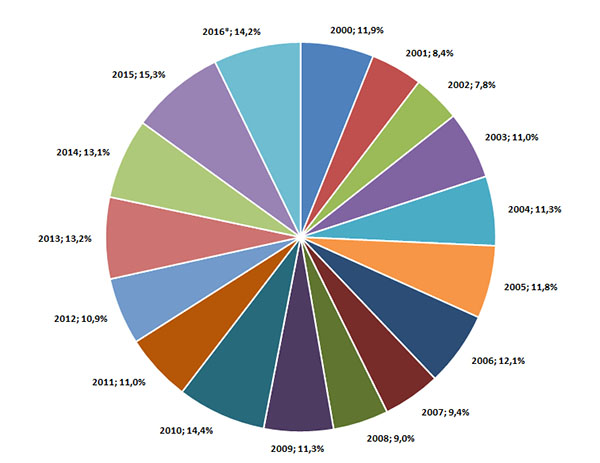| RENEWABLE ENERGY CONSUMPTION |
Renewable energy sources are defined as renewable non-fossil energy sources: hydropower, geothermal, solar and wind power; solid biomass; biogas, liquid biofuels, etc.
The indicator “Renewable energy consumption” is expressed as ratio of total renewable energy consumption and the total energy consumption originating from all fuels (in percentage).
- thousand tonnes of oil equivalent (ktoe)
- percentage (%)
How fast is the share of renewable energy inthe total energy consumption?
Policies in energy sector should favour measures for greater use of renewable energy sources.
Relatively low share of renewable energyin the total energy consumption (11.5% at an average) indicates dominant use of fossile fuels which is unfavourable in terms of both depletion of energy resources and environmental pollution.
Biomass has the highest share of renewable energyin the total energy consumptionand ranges from 5.1% to8.7%, while the lowest share belongs to solar electric energy.Hydro electricity has a share in the range between 2 and 7.3%.
Figure 1. Share of renewable energy in the total energy consumption by energy source (%)
Figure 2. Total share of renewable energy in the total energy consumption (%)
Data coverage: excel
Source: State Statistical Office, http://www.stat.gov.mk/Default_en.aspx
Relatively low share of renewable energy in the total energy consumption (11.45% at an average) indicates the dominant use of fossile fuels which is unfavorable in terms of both energy resources depletion and environment pollution. The highest share of renewable energy in the total energy consumption was recorded in 2015 with 15.3%, and the lowest one of 7.8% in 2002.
During the reporting period, the trend of renewable energy share in the total energy consumption was variable. In the period from 2000to 2002, there was a drop by 34.6%, and from 2002 to 2006 there was a growth by39.6% in the share of renewable energy in the total energy consumption, followed by decline in 2007 by28%, and then growth again in the period from 2008 to 2010 of73.5%, and significant decline in the period from 2011 to 2014 amounting24.6%.
Biomass has the highest share of renewable energyshare in the total energy consumptionand ranges from 5.1% to8.7%, while the lowest share belongs to solar electric energy.Hydro electricity has a share in the range between 2% and 7.3%.
The minimal share of renewable energy sources in the share of the total energy production and consumptionin the Republic of Macedonia indicates that the available resources (e.g.geothermal, hydro, solar power and other) are insufficiently utilized, but also the aspects of energy security, in terms of all steps that need to be undertaken by the state to prevent threats in relation to planned demands for energy by the national economy. Energy security or threat to economy and social welfare the factors of which are minimized with reduction of dependence on energy and energy resources import, indicate the importance of social resources streamlining towards maximum utilization of natural renewable sources.
- Methodology for the indicator calculation
Statistical methodology for calculation:
- Regulation on Energy Statistics of the European Parliament and of the Council (Regulation no.1099/2008),
- “Energy Statistics Methodology Eurostat F4, 1998″
- Strategy for Energy Efficiency in the Republic of Macedonia by 2020[1]
- Strategy for Energy Development in the Republic of Maceodnia by 2030[2]
- Strategy for Utilization of Renewable Energy Sources (RES) in the Republic of Macedonia by 2020[3]
Legal grounds
Law on Energy; Energy Balance of the Republic of Macedonia – annual planning document defining the demands for energy and the possibility for their supply (Article 16 of the Law on Energy).
Reduction in the dependence on imported fuels and reduction in inefficient energy consumption;
Modernization of energy infrastructure and diversification of energy supply;
Participation in of regional cooperation and compliance with the legislation of the Energy Community.
- Eurostat
- ECE/UN
- IEA/OECD
| Code | Title of the indicator | Compliance with CSI/ЕЕА or other indicators | Classification by DPSIR | Type | Linkage with area | Frequency of publication | |
| MKNI 030 | Renewable energy consumption | CSI 030
EE 26 |
Renewable energy
consumption |
R | B | energy | annualy |







































































